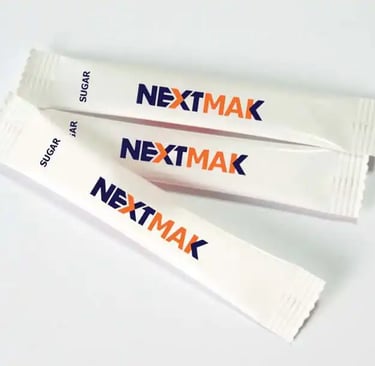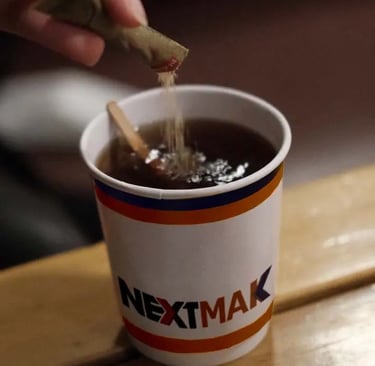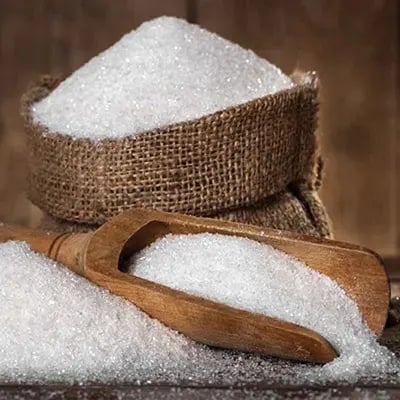Talk with us on WhatsApp: +90 535 106 7000
SUGAR PACKAGING
NEXTMAK.COM > SOLUTIONS > SUGAR PACKAGING
Sugar is a type of carbohydrate that is commonly used as a sweetener in food and beverages. Chemically, sugar refers to a group of compounds known as saccharides, which can be further categorized into monosaccharides, disaccharides, and polysaccharides. The most common type of sugar used for human consumption is sucrose, which is a disaccharide composed of glucose and fructose molecules.
Sugar is primarily made through the processing of sugarcane or sugar beet plants.
Sugar packaging refers to the materials and methods used to package and distribute granulated sugar, which can come in various forms. The most common types of sugar packaging are:
Glass or plastic jars: Granulated sugar can be packaged in glass or plastic jars with a screw-on or snap-on lid. These jars are often reusable and can be used for long-term storage of sugar.
Paper or plastic bags: Granulated sugar can also be packaged in paper or plastic bags, which are often resealable to keep the sugar fresh. These bags are often used for bulk distribution of sugar to commercial customers such as bakeries and restaurants.
Boxes: Powdered sugar is often packaged in boxes with plastic bags inside.
Stick packs: stick packs are small, individual packets of granulated sugar that can be used as a convenient way to sweeten beverages and food. They are often made from paper or plastic and can be opened by tearing off one end.
The packaging of sugar also involves the use of labels and branding, which can include information such as the sugar's origin, weight, and nutritional information. The packaging material may also be biodegradable or eco-friendly to reduce environmental impact.
Overall, sugar packaging plays an important role in preserving the quality and freshness of the sugar, as well as making it convenient and easy to use, transport, and store.
Sugar stick packs are small, individual packets of granulated sugar that are commonly used in restaurants, cafes, and other food service settings as a convenient way to sweeten beverages and food. They are often made from paper or plastic and can be opened by tearing off one end. They are also sometimes referred to as sugar packets, sugar sachets, or sugar sticks.
Sugar stick packs can come in different sizes and quantities, depending on the manufacturer and the intended use. They may be sold in bulk to commercial customers, or in smaller quantities for home or individual use. Some sugar stick packs may also contain artificial sweeteners or sugar substitutes, rather than granulated sugar. They can also be used in the home and office as a way to control the amount of sugar that is being used. Some people may find it a more hygienic way of adding sugar to their drinks or food as they are individually sealed.
In addition to being used in food service and home settings, sugar stick packs are also popular as a travel accessory. They are small and lightweight, making them easy to pack and take on the go. Many hotels, airlines, and other travel providers also offer sugar stick packs as a complimentary service to guests.
Sugar stick packs are also a great option for people who are looking to reduce their sugar intake, as they allow for precise measurement and control of the amount of sugar used. They are also a convenient option for people who are trying to reduce the amount of plastic waste they produce, as many brands now offer eco-friendly paper-based or biodegradable options.
Overall, sugar stick packs are a versatile and convenient option for sweetening food and beverages and can be used in a variety of settings, from food service and home kitchens to travel and on the go.
See our Sugar Stick Pack Machine for more details.
SUGAR STICK PACKS
Sugar has an indefinite shelf life when stored properly. It is a non-perishable item that does not spoil, go bad, or expire. However, the quality of the sugar may change over time. Factors such as humidity, temperature, light, and air exposure can affect the texture, color, and taste of the sugar.
If sugar is stored in a cool, dry place, it can retain its quality for a long time. Airtight containers such as glass jars or plastic containers with tight-fitting lids can help prevent moisture from getting in and clumping or hardening the sugar. Avoid storing sugar in damp or humid places, as this can cause clumping and discoloration.
Powdered sugar has a shorter shelf life than granulated sugar as it can become lumpy and lose its texture over time if exposed to moisture.
It is also important to note that opened sugar packets, stick packs, or any other opened packages should be closed properly after use, to prevent moisture and other contaminants from getting in.
In general, sugar will retain its quality for a long time when stored properly, but over time, the quality may decline. If sugar is clumpy, discolored, or has a strange odor, it's best to discard it and buy a fresh package.
SUGAR SHELF LIFE
Sugar Stick Pack Machine
If you are planning to involve in this business, take a look at our Sugar Stick Pack Machine.

© 2024 NEXTMAK | PRODUCTS | SOLUTIONS | SUPPORT | REFERENCES | CONTACT | GET A QUOTE
ERAS PACK AMBALAJ
VE MAKİNE SAN. TIC. LTD. STI.
Address
İkitelli OSB, Saraçlar Sanayi Sitesi, Blok: 7
Başakşehir / Istanbul / TÜRKİYE
TEL/WhatsApp: +90 535 106 7000
TEL/WhatsApp: +90 536 662 3672
Email: export@nextmak.com - info@nextmak.com






